In the realm of electrical engineering and electronics, the capacitor is a vital component with a wide range of applications. It stores electrical energy using an electric field and can release it as required. This ability to store and release charge makes capacitors essential for managing voltage fluctuations, improving signal quality, and performing other critical functions in electronic circuits.
This post discourses upon an exploration of the fundamental principles, construction methodologies, various types, and practical applications of electrical capacitors.
What Is An Electrical Capacitor?
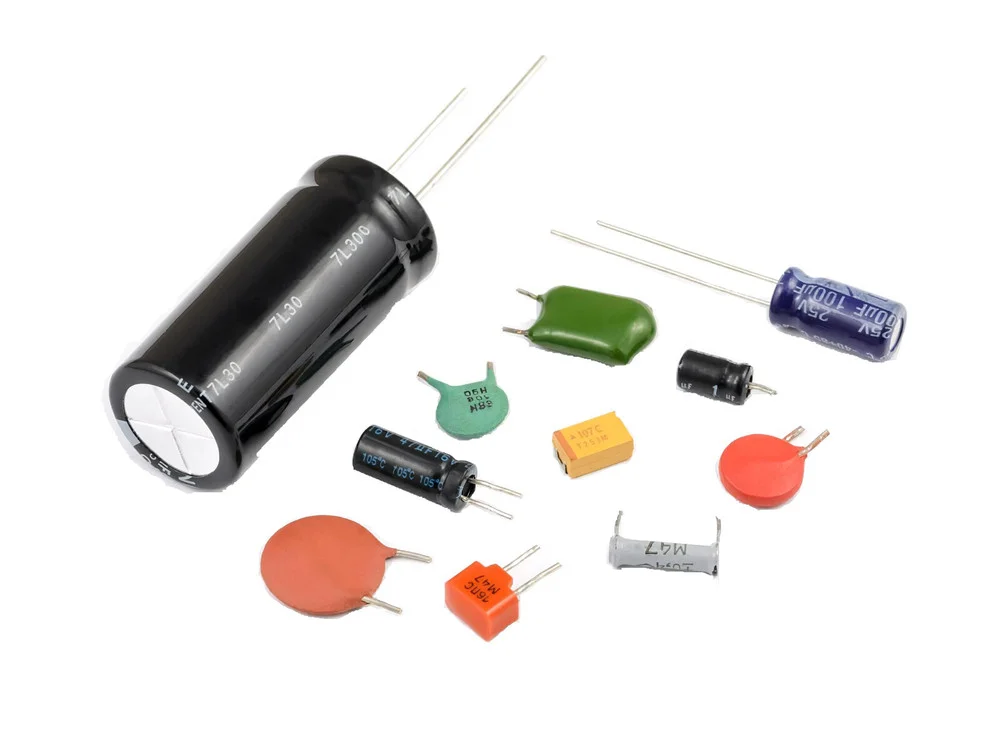
An electrical capacitor, commonly known as a capacitor, stands as a vital component in electronic circuits. It retains electrical energy within an electric field formed between two conductive plates separated by an insulating material known as a dielectric. Upon application of voltage, the capacitor charges up, storing energy which can be subsequently discharged as needed, delivering a surge of power to the circuit.
Electrical Capacitors manifest in diverse shapes, sizes, and types, each tailored to specific applications. They assume crucial roles in various tasks such as smoothing voltage fluctuations, filtering signals, tuning circuits, and storing energy across numerous electronic devices and systems. From miniature capacitors in consumer electronics to sizable ones in power systems, they pervade modern technology.
Electrical Capacitor Construction
An electrical capacitor consists of two conductive metal plates parted by an insulating substance called a dielectric. Typically, the plates are crafted from metals like aluminum or tantalum, while the dielectric can comprise various insulating materials such as paper, glass, or ceramic. These materials proficiently inhibit current flow between the plates.
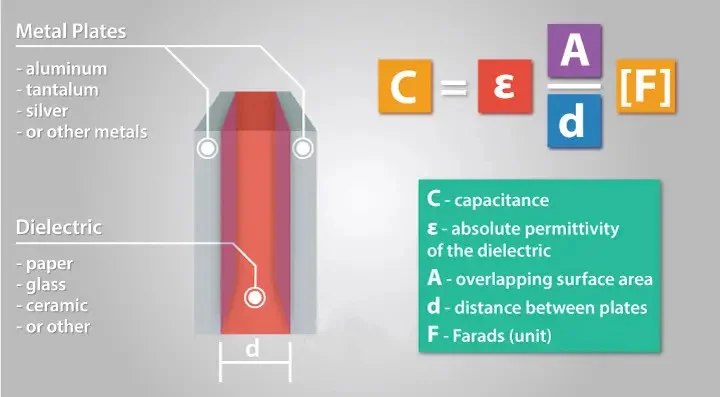
The capacitance of a capacitor, quantified in farads, relies on various determinants. It correlates directly with the plate surface area and the dielectric material’s permittivity (ε). Moreover, capacitance escalates as the distance separating the plates diminishes. Armed with this comprehension of its structure, let’s explore the workings of a capacitor.
How Electrical Capacitors Work?
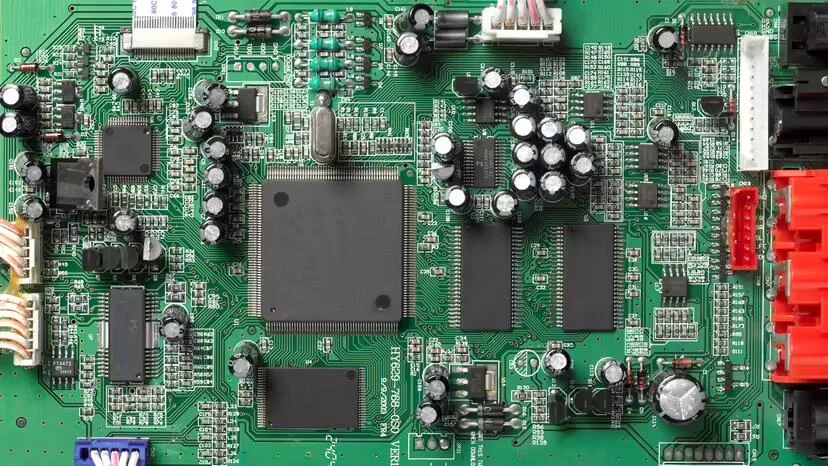
Electrical capacitors operate by storing and releasing electrical energy through the establishment of an electric field. Upon application of a voltage, the capacitor charges by accumulating positive and negative charges on its plates, which are divided by a dielectric material. This charge accumulation generates an electric field between the plates.
During the charging process, electrons migrate from one plate to the other until the potential difference across the capacitor aligns with the applied voltage. Once charged, the electrical capacitor retains this electrical energy until required.
Upon demand for additional power or in response to voltage fluctuations, the capacitor discharges, swiftly releasing the stored energy back into the circuit. This discharge process delivers a rapid burst of power, stabilizing voltage levels or satisfying the circuit’s requirements.
In essence, electrical capacitors store electrical energy within an electric field between two plates separated by a dielectric, releasing it as necessary to stabilize voltage levels or supplement power within the circuit.
Types Of Electrical Capacitors
Ceramic Capacitors
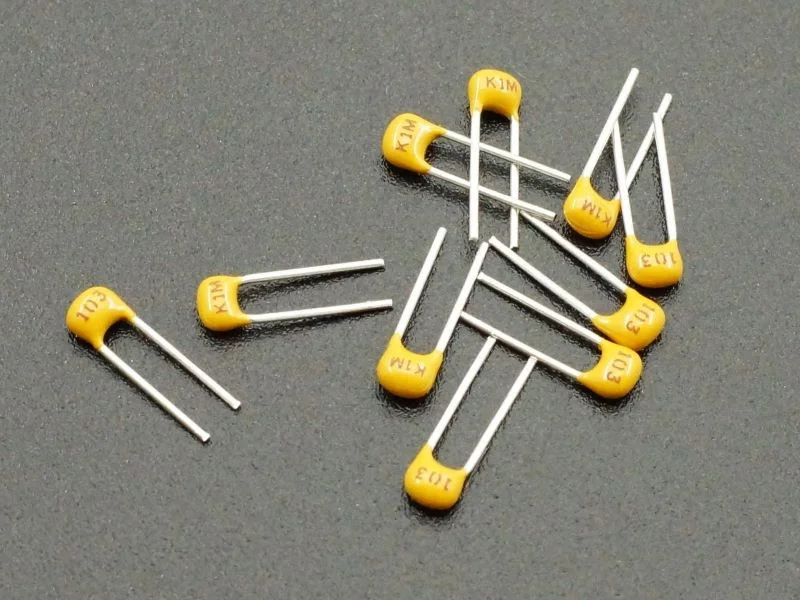
Ceramic Capacitors, also known as Disc Capacitors, consist of silver-coated ceramic discs stacked together. Single discs, measuring 3-6mm, suffice for low capacitance values. Their high dielectric constant enables high capacitance in a compact size.
They exhibit substantial non-linear changes in capacitance with temperature fluctuations, rendering them suitable for application as de-coupling or bypass capacitors. Moreover, they function as non-polarized devices. While ceramic capacitors typically span capacitance values ranging from a few picofarads to one or two microfarads (μF), their voltage ratings are generally moderate.
Ceramic capacitors are usually designated with a 3-digit code on their body, indicating their capacitance value in picofarads. Typically, the initial two digits denote the capacitor value, while the third digit indicates the number of zeros to be appended. For example, a ceramic disc capacitor marked with “103” would signify 10 and 3 zeros in picofarads, equating to 10,000 pF or 10nF.
Electrolytic Capacitor
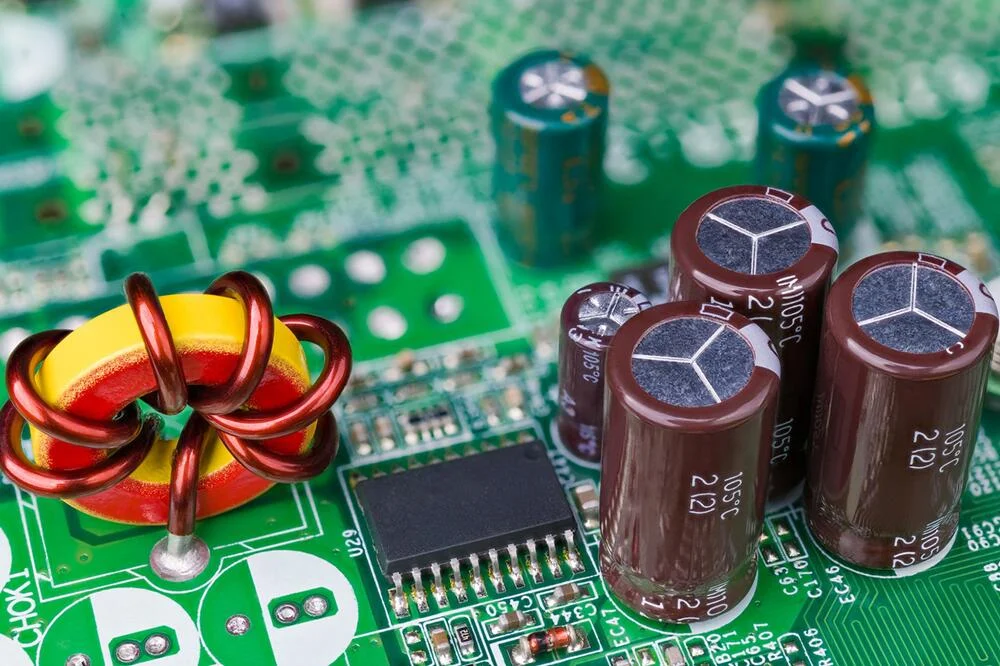
Electrolytic capacitors employ an electrolyte as the dielectric material, allowing them to attain high capacitance values despite their relatively compact size. This unique construction makes electrolytic capacitors indispensable in applications requiring elevated capacitance levels, thanks to their polarized nature with distinct positive and negative terminals.
These applications encompass power supply filtering, where electrolytic capacitors adeptly smooth out voltage ripples, and audio coupling, facilitating the transmission of audio signals. Moreover, electrolytic capacitors are prevalent in various electronic circuits where space constraints coexist with the demand for high capacitance, cementing their significance as a vital component in modern electronics.
Film Capacitors
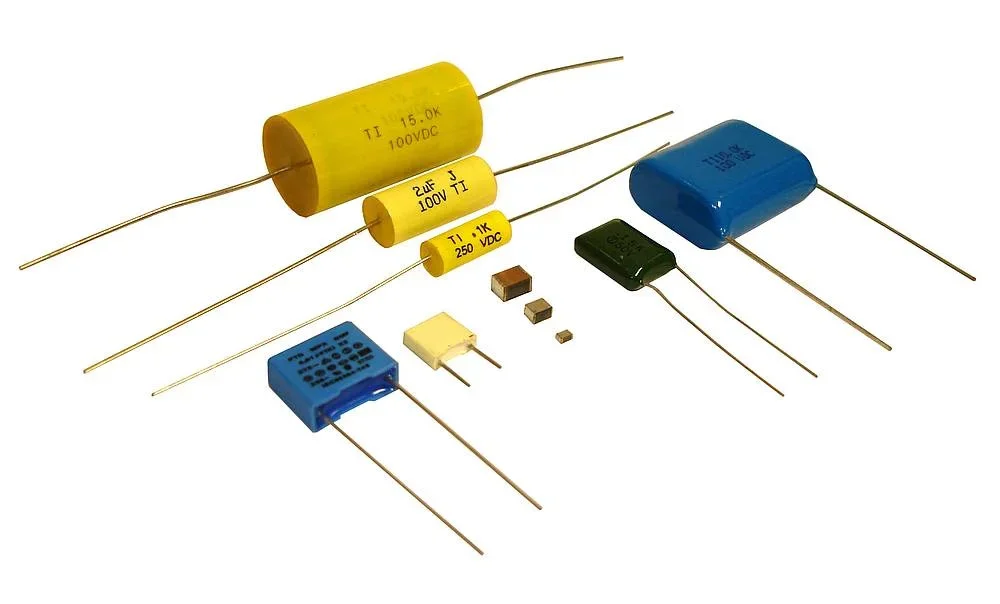
Film capacitors are a type of capacitor that employs a thin plastic film as the dielectric material. This design imparts several advantageous characteristics to film capacitors. Firstly, they offer high stability, ensuring consistent performance over time and under varying conditions. Additionally, film capacitors exhibit low leakage, meaning they retain stored charge effectively.
Moreover, they possess excellent self-healing properties, enabling them to recover from minor breakdowns or damage. Film capacitors are available in various types to suit different applications. One common type is the polyester film capacitor, also known as Mylar capacitor, which offers good performance at a relatively low cost.
Another type is the polypropylene film capacitor, prized for its high reliability and superior electrical properties. Additionally, metalized film capacitors feature a metalized film construction, providing enhanced capacitance density and improved thermal performance.
Tantalum Capacitors
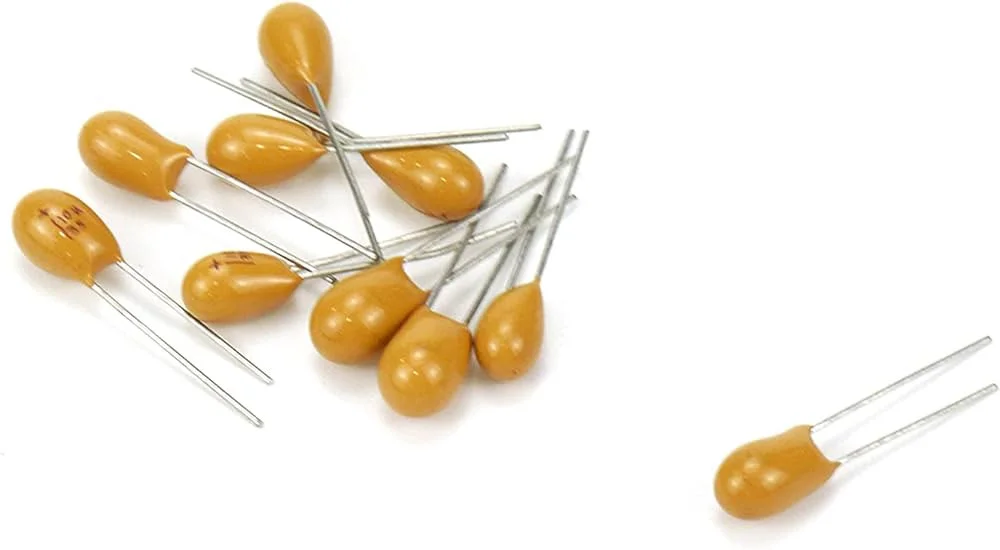
Tantalum capacitors are renowned for their exceptional capacitance density, achieved through the use of tantalum metal as the anode material and a thin oxide layer as the dielectric. This distinct design allows tantalum capacitors to attain remarkably high capacitance values in relation to their small physical size.
Thanks to this advantageous combination of high capacitance density and compact form factor, tantalum capacitors find widespread use in compact electronic devices such as smartphones, laptops, tablets, and portable consumer electronics.
Supercapacitors
Supercapacitors, also known as ultracapacitors, represent a specialized type of capacitor renowned for their exceptionally high capacitance density. This unique characteristic allows supercapacitors to store and deliver significant amounts of energy rapidly, making them indispensable in various applications requiring swift energy storage and release.
One notable application of supercapacitors is in regenerative braking systems utilized in electric and hybrid vehicles. During braking, these systems capture the kinetic energy produced by the vehicle’s motion and store it in supercapacitors for future use. By effectively capturing and storing this energy, supercapacitors contribute to enhanced energy efficiency and extend the driving range of electric vehicles.
What Are Electrical Capacitors Used For?
Electrical capacitors constitute a fundamental element of electronic systems, playing a crucial role in various applications. They are primarily utilized for storing energy, conditioning power, filtering electronic noise, remote sensing, and facilitating signal coupling and decoupling.
Decoupling (Bypass) Capacitors
Decoupling capacitors, also known as bypass capacitors, are a common example of an electrical capacitor. They are typically used in conjunction with integrated circuits and positioned between the power source and the ground of the IC.
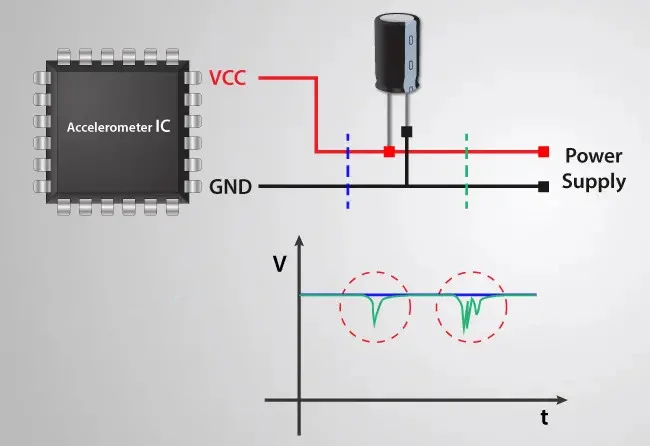
Their primary function is to filter out noise in the power supply, such as voltage ripples that occur during brief drops in voltage or fluctuations caused by switching parts of the circuit. When these voltage drops happen, the capacitor temporarily acts as a power supply, bypassing the main power source to maintain a steady voltage.
AC Coupling & DC Blocking
Another typical application of an electrical capacitor is in DC adapters, where it plays a crucial role in converting AC voltage to DC voltage. A diode rectifier is usually employed for this conversion process. However, without the assistance of capacitors, the rectifier alone would not be able to effectively accomplish the task.
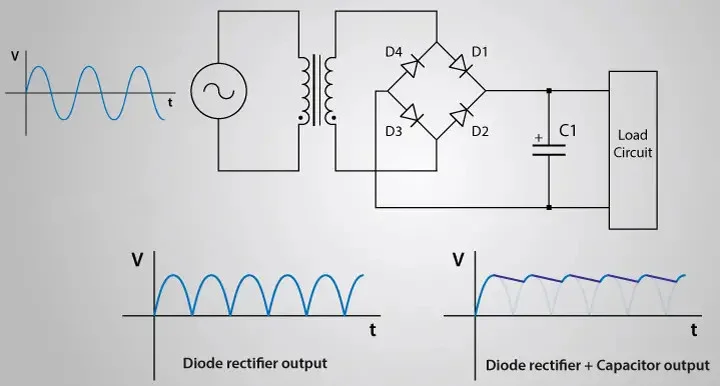
The rectifier doesn’t output a smooth DC signal, but rather a pulsating waveform. This is where the capacitor plays a crucial role. As the rectifier’s output voltage rises, the capacitor charges, storing electrical energy. When the rectifier’s output voltage drops, the capacitor discharges, releasing the stored energy. This charging and discharging process fills in the gaps of the pulsating waveform, smoothing out the DC output.
Essentially, the capacitor serves as a buffer, ensuring that the fluctuations in the rectified voltage are leveled. This results in a more stable and consistent DC voltage, essential for the proper operation of many electronic devices. Without the capacitor’s smoothing effect, the DC adapter would provide a less stable output, potentially causing performance issues in connected devices.
Signal Filtering
Signal filtering is another key application of an electrical capacitor. Thanks to their specific response time, capacitors can effectively block low-frequency signals while allowing higher frequencies to pass through. This property is particularly useful in various electronic devices.
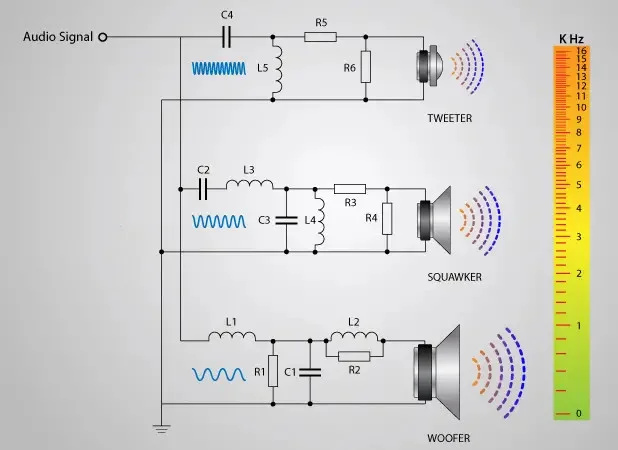
In radio receivers, for instance, capacitors are employed to tune out undesired frequencies, ensuring that only the desired high-frequency signals are received, which enhances the clarity and quality of the radio signal. Similarly, in audio systems, capacitors play a crucial role in the crossover circuits within speakers.
These circuits separate the audio signal into different frequency ranges, directing low frequencies to the woofer and higher frequencies to the tweeter. This separation ensures that each speaker component operates within its optimal range, resulting in better sound clarity and overall audio performance.
Energy Storage
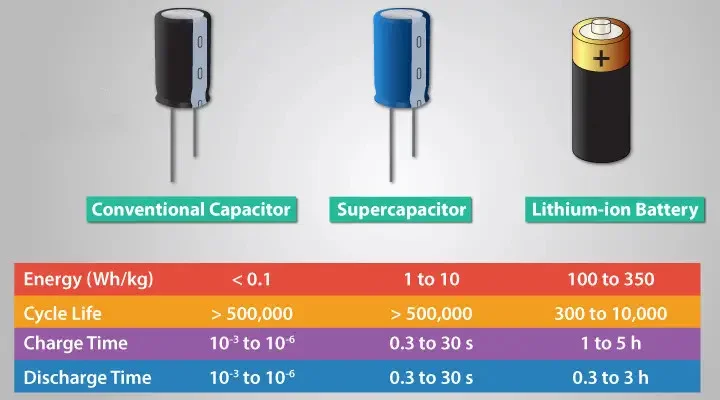
Another notable use of the electrical capacitor is for energy storage and supply. While capacitors store significantly less energy compared to a battery of the same size, they have a much longer lifespan and can deliver energy much faster. This makes them ideal for applications requiring quick bursts of power.
What Are The Advantages Of Electrical Capacitors?
Power Factor Correction:
Power factor correction is a crucial function in industrial settings, where electrical capacitors play a vital role. In industrial plants, the presence of inductive loads can cause a drop in power factor, leading to reduced energy efficiency. Capacitors come into play by enhancing the power factor, thus optimizing energy consumption. They achieve this by balancing inductive reactive power, thereby improving overall energy efficiency.
Voltage Stabilization:
Electrical capacitors are indispensable in combating voltage fluctuations, a common occurrence in electrical systems, particularly when abrupt load changes occur. These fluctuations can disrupt the stability of the voltage supply, potentially affecting the performance of electronic devices. Capacitors step in to address this issue by effectively equalizing these fluctuations, thereby stabilizing the voltage output.
Through their ability to absorb and release electrical energy as needed, capacitors ensure a consistent and reliable voltage supply, crucial for the uninterrupted operation of electronic devices. In essence, capacitors act as guardians, safeguarding electronic systems against the adverse effects of voltage variations, and thus play a vital role in ensuring the smooth and dependable operation of electrical devices and systems.
Filtering:
Electrical capacitors serve as essential components in electronic circuits, tasked with the critical role of mitigating unwanted noise and harmonics. In electronic devices and circuits, the presence of noise and high-frequency harmonics can result in disruptive interference, compromising performance and signal integrity.
Capacitors effectively combat these issues by absorbing and neutralizing these undesirable frequency components. Through this process, capacitors play a pivotal role in diminishing circuit noise levels, thereby enhancing overall signal quality and ensuring optimal functionality of electronic systems.
Starting And Accelerating:
Electrical capacitors play a vital role in kick-starting and enhancing the efficiency of devices demanding significant starting currents, notably electric motors. During the motor’s initial startup phase, capacitors enable it to draw an augmented current, effectively providing the requisite torque for smooth operation from the outset.
This process ensures that the motor swiftly transitions from standstill to operational speed, optimizing performance and minimizing delays in the system. By facilitating the provision of ample starting current, capacitors contribute to the seamless and reliable operation of electric motors across various applications, ranging from industrial machinery to household appliances.
Conclusion
In conclusion, the electrical capacitor emerges as an indispensable component within the realm of electrical engineering and electronics. Its ability to store and release electrical energy, coupled with its versatility in mitigating voltage fluctuations and filtering signals, renders it a cornerstone of modern technology.
Through an understanding of their fundamental principles, construction, types, and applications, engineers and enthusiasts alike can harness the power of electrical capacitors to drive forward progress and innovation in the ever-evolving field of electronics.